Multimodal Dataset Construction and Validation for Driving-Related Anger: A Wearable Physiological Conduction and Vehicle Driving Data Approach
Abstract
:1. Introduction
1.1. Limitations of Existing Driving Emotion Datasets
1.2. Our Contributions
- Development of a Procedure for Evoking Driving Anger: We designed a comprehensive procedure to evoke anger. Video clips were used as preliminary evocation material in a driving simulator environment. In contrast, traffic simulation software encoded scenarios as continuous and deep evocation materials during the experiment. This combination effectively evoked anger in participants and established a framework for collecting valid data on their spontaneous expressions of anger;
- Construction of a Simulated Driving Experiment Environment Using a Simulation Platform: We recruited 56 participants of varying ages and driving experiences to collect data on EEG, EDA, vehicle driving behavior (including acceleration, speed, lane offset, and steering wheel angle), and Self-Assessment Manikin (SAM) under both angry and neutral emotional states. This approach enabled the creation of a multimodal dataset capturing drivers’ spontaneous expressions of anger, effectively addressing the scarcity of data for research on driving emotion recognition. Additionally, a real-world driving experiment was designed to collect multi-source data and validate the applicability of the DPV-MFD in real driving environments;
- Preprocessing and Quality Validation of Synchronized Physiological and Vehicle Driving Data in the Multimodal Dataset: We first verified the validity and correlation between the multimodal data and emotion labels across three dimensions. Subsequently, the DPV-MFD was applied to the existing CNN (Convolutional Neural Network-Long Short-Term Memory) deep learning network to evaluate the emotion recognition accuracy of multichannel time series under different time windows. Performance experiments on driving anger recognition were conducted using multimodal information fusion. The experimental results demonstrated that multimodal signal fusion significantly outperformed single-modal signals in recognizing driver emotions, providing a viable direction for future research.
2. Related Work
2.1. Cognitive Evaluation Methods for Driving Emotions
2.2. Emotion Evocation Techniques Based on Driving Simulators
2.3. Multimodal Driving Emotion Datasets
- Machine vision and image processing studies of facial expressions and body postures;
- Speech text and acoustic recognition studies;
- Parametric studies of vehicle driving status and driver behavior;
- Analyses of EEG signals from the central nervous system and various physiological signals from the autonomic nervous system.
3. Experimental Design and Data Collection Methods
3.1. Ethical Statement
3.2. Emotion Evocation Analysis
- What movie clips have left the strongest impression on you in terms of evoking feelings of anger?
- Which traffic scenarios or specific incidents have you encountered while driving that made you feel slightly or even extremely angry?
- After viewing the road rage-triggering incidents summarized from the news analysis displayed on the large screen, please provide an open-ended response, focusing on the extent to which these incidents evoke anger.
3.3. Experiment 1: Selecting Emotion Evocation Materials Using a Questionnaire Survey
3.3.1. Experiment 1-Participant Demographic Information
3.3.2. Experiment 1-Procedure
3.3.3. Evoked Material Selection
- After ensuring that pedestrians are prioritized through the intersection, vehicles start and then face a prolonged red-light signal (65.06%);
- When non-motorized vehicles persistently occupy lanes designated for motorized vehicles (62.02%);
- When pedestrians disregard traffic signals and proceed slowly (58.49%);
- Failure to pass due to randomly parked vehicles not by regulations (51.92%);
- Overloaded traffic flow causes prolonged congestion (50.96%);
- Nearby vehicles intentionally obstructing traffic (47.76%).
3.4. Experiment 2: Constructing a Multimodal Anger Emotion Dataset through Driving Simulation
3.4.1. Experiment 2-Participant Demographic Information
3.4.2. Experimental Environment Setup
- (a)
- EEG Signal Collection Module
- (b)
- EDA Signal Collection Module
- (c)
- Vehicle Driving Data Collection Module
3.4.3. Constructing 3D Traffic Simulation Scenarios
3.4.4. Experiment 2-Procedure
- Experiment Preparation Phase: Before the formal experiment begins, researchers must thoroughly explain the experiment’s requirements and guidelines to the participants, such as the need to complete time-constrained tasks on schedule and prohibition against violating any traffic rules. Participants must also avoid experiencing significant emotional fluctuations within the hour preceding data collection to ensure the accuracy of EEG and EDA data. Participants then complete a demographic questionnaire covering gender, age, driving experience, education level, handedness, and history of traffic conflicts or accidents.
- Experiment Calibration Phase: Participants are fitted with the EEG and EDA devices, followed by equipment calibration and signal stability checks. They then undergo a 5 min-adaptation session with the driving simulator to familiarize themselves with the controls, such as the steering wheel, accelerator, brake, and clutch. After this pre-experiment session, participants sit quietly for 3 min to adjust their emotional and physical state, minimizing the impact of wearing physiological monitoring equipment.
- Control Experiment Phase: Once prepared for driving, participants listen to 5 min of ambient music featuring natural landscapes to calm their minds and ensure a neutral emotional state before the main experiment. They then perform a 10 min-free driving task along a predefined route in a basic scenario involving a two-way, four-lane rural road with scenic surroundings and low traffic flow. During this period, physiological and vehicle driving data are continuously collected for 2 min once the physiological signals stabilize. Upon completing the task, participants report their emotional state and level using the SAM emotion assessment scale and take a 5 min-break.
- Anger Evocation Phase: After resting, the start time for anger evocation is determined based on the participant’s physiological signals. Once the signals stabilize, participants watch a pre-selected 12 min-movie clip to evoke anger as an initial stimulus. After viewing, participants use the SAM emotion activation scale to report their emotional state to the observer objectively. Participants are only allowed to enter the driving simulator if their valence score reaches levels 3 or 4 and their arousal score reaches levels 5 or 6. During the simulated driving task, participants randomly encounter six different traffic scenarios. To maintain anger activation and achieve a more profound evocation, four additional drivers using networked simulators provide interference, such as flashing high beams from oncoming traffic and nearby vehicles cutting in unexpectedly. Each experiment is designed to be completed in about 180 s, during which participants must not violate any traffic rules. When encountering particular scenarios, participants must again objectively report their emotional state and the effectiveness of the evocation to the observer. Simultaneously, the observer assesses the participant’s emotional state based on their driving experience, micro-expressions, body language, breathing patterns, or actions (such as sudden braking, gripping the steering wheel tightly, or hitting the dashboard).
- Experiment Conclusion Phase: At the end of the experiment, SAM emotion activation scales are collected, and questionnaires under the same emotional evocation are categorized. Questionnaires with inconsistent or uncertain emotional responses are excluded, prioritizing those with more substantial evocation effects. The specific process is illustrated in Figure 6.
3.4.5. Dataset Content
3.5. Experiment 3: Validation in Real-Vehicle
3.5.1. Real-World Driving Test Overview
3.5.2. Experiment 3-Participant Demographic Information
3.5.3. Experiment 3-Procedure
3.6. Data Processing
3.6.1. EEG Signal Preprocessing
- Data Segmentation and Filtering: In the driving simulation experiment and the real vehicle experiment, the participants were stimulated by different traffic scenarios, leading to the segmentation of EEG data into multiple epochs, each representing a specific time window. However, EEG signals are susceptible to interference from various noise sources or artifacts, such as eye movements, muscle activity, and electrical power interference. These disturbances can contaminate certain epochs, rendering them unsuitable for subsequent analysis. To address this, a rejection threshold of 75 μV was established for epochs, and a band-pass filter was applied with a frequency range set to [0.5 Hz, 40 Hz] to suppress low-frequency and high-frequency noise effectively;
- Time Window Selection: Based on each marked time point, this study selected a time interval of −0.5 s, 1.5 s corresponding to the filtered data samples of vehicle driving. This time interval served only as a reference for technical validation and was not intended as a mandatory segmentation criterion;
- Data Segmentation and Filtering: the ICA algorithm in MATLAB’s EEGLAB toolbox and recommended standards and typical artifact paradigms (including noticeable eye movement artifacts, muscle motion artifacts, and abnormal electrode artifacts) were used to judge and process the signals comprehensively.
3.6.2. EDA Signal Preprocessing
3.6.3. Validation of Vehicle Driving Data Quality
4. Validity Testing of the Multimodal Dataset
4.1. Validity Verification of Emotion Labels
4.1.1. Validity Evaluation of SAM Labels Based on t-SNE Three-Dimensional Clustering
4.1.2. Subjective Rating Analysis
4.2. Correlation Analysis between Multimodal Data and Emotion Labels
4.2.1. EEG Data and Emotion Labels
4.2.2. EDA Data and Emotion Labels
4.2.3. Vehicle Driving Data and Emotion Labels
4.3. Performance Evaluation of the DPV-MFD Multimodal Dataset Using CNN-LSTM Network
4.3.1. Multimodal Fusion Architecture Based on CNN-LSTM
- Preprocessing: After preprocessing the raw data described in Section 3.6, the sliding window method was used to divide the features of each modality into fixed-size overlapping time windows, generating a new training dataset.
- Feature Extraction: The new training dataset for each modality was fed into the 1D-CNN and LSTM framework for feature extraction. Specifically, the segmented time windows from the training data were first input into the 1D-CNN, which automatically learned the features. The feature extraction framework consists of three 1D convolutional layers, three max-pooling layers, and two LSTM layers. The convolutional layers use sliding filters to extract relevant features, and the activation function is the Exponential Linear Unit (ELU), which accelerates convergence and enhances model robustness. Each convolution layer is followed by a max-pooling layer that reduces data volume by half, reducing complexity. A dropout layer is applied after pooling to prevent overfitting. After three convolution and pooling layers, the input data are transformed into high-dimensional feature maps. Since the convolution and pooling operations preserve the temporal sequence, the feature maps are directly fed into the two-layer LSTM network, converting them into corresponding hidden states.
- Feature Fusion: The hidden states generated from the EEG, EDA, and vehicle driving data are integrated into a new feature map containing n hidden states ht, represented as H.
- Classification: The vector S is computed as the weighted sum of the hidden states. In the final classification step, the vector S is used as the input feature to the Softmax layer for emotion classification.
4.3.2. Model Training Process
4.3.3. Performance Evaluation Metrics
4.3.4. Results
- A.
- Driving Anger Emotion Recognition Based on Unimodal EEG
- B.
- Driving Anger Emotion Recognition Based on Multimodal Information Fusion
- C.
- Actual driving verification validation
- D.
- Comparative Analysis of CNN-LSTM Fusion Model with Existing Driver Emotion Recognition Research
5. Limitations and Future Research
6. Conclusions
- Validation of Emotional Labeling: the reliability of the SAM scale in assessing emotion evocation effects was validated through t-SNE dimensionality reduction clustering analysis of emotional labels and the distribution of SAM scores based on participants’ self-reports.
- Data Quality and Consistency Evaluation: EEG, EDA, and vehicle driving data were subjected to noise reduction and quality checks. The stationary distribution of the multimodal data waveforms from all participants during the experiments assessed the data’s stability and consistency.
- Correlation Analysis: the Spearman correlation coefficient was used to explore the relationships between multimodal data and the three emotional dimensions, examining the strength of the association between different modal features and emotional dimensions.
- Performance Evaluation of Emotion Recognition: The publicly available CNN-LSTM deep learning network was used to assess the performance of the DPV-MFD in emotion recognition, comparing the effectiveness of unimodal and multimodal data. The results showed that integrating multimodal information significantly improved the accuracy of angry driving emotion recognition, confirming the effectiveness of multi-source information fusion. Furthermore, the high degree of alignment between emotion recognition results from real-world driving data and simulated driving data confirmed the generalizability of the DPV-MFD in real-world driving scenarios.
Author Contributions
Funding
Data Availability Statement
Conflicts of Interest
References
- Bowen, L.; Budden, S.L.; Smith, A.P. Factors underpinning unsafe driving: A systematic literature review of car drivers. Transp. Res. Part F Traffic Psychol. Behav. 2020, 72, 184–210. [Google Scholar] [CrossRef]
- Woldu, A.B.; Desta, A.A.; Woldearegay, T.W. Magnitude and determinants of road traffic accidents in Northern Ethiopia: A cross-sectional study. BMJ Open 2020, 10, e034133. [Google Scholar] [CrossRef]
- Wang, B.; Han, Y.; Wang, S.; Tian, D.; Cai, M.; Liu, M.; Wang, L. A review of intelligent connected vehicle cooperative driving development. Mathematics 2022, 10, 3635. [Google Scholar] [CrossRef]
- Sahoo, G.K.; Das, S.K.; Singh, P. Performance comparison of facial emotion recognition: A transfer learning-based driver assistance framework for in-vehicle applications. Circ. Syst. Signal Process. 2023, 42, 4292–4319. [Google Scholar] [CrossRef]
- Habibifar, N.; Salmanzadeh, H. Improving driving safety by detecting negative emotions with biological signals: Which is the best? Transp. Res. Rec. 2022, 2676, 334–349. [Google Scholar] [CrossRef]
- Khattak, A.J.; Ahmad, N.; Wali, B.; Dumbaugh, E. A taxonomy of driving errors and violations: Evidence from the naturalistic driving study. Accid. Anal. Prev. 2021, 151, 105873. [Google Scholar] [CrossRef]
- Huang, T.; Fu, R.; Chen, Y. Deep driver behavior detection model based on human brain consolidated learning for shared autonomy systems. Measurement 2021, 179, 109463. [Google Scholar] [CrossRef]
- Van Kleef, G.A.; Côté, S. The social effects of emotions. Annu. Rev. Psychol. 2022, 73, 629–658. [Google Scholar] [CrossRef]
- Bru-Luna, L.M.; Martí-Vilar, M.; Merino-Soto, C.; Cervera-Santiago, J.L. Emotional intelligence measures: A systematic review. In Proceedings of the Healthcare, Basel, Switzerland, 9–12 December 2021; MDPI: Basel, Switzerland, 2021. [Google Scholar]
- Zhang, F.; Markopoulos, P.; Bekker, T.; Paule-Ruíz, M.; Schüll, M. Understanding design-based learning context and the associated emotional experience. Int. J. Technol. Des. Educ. 2022, 32, 845–882. [Google Scholar] [CrossRef]
- Younis, E.M.G.; Zaki, S.M.; Kanjo, E.; Houssein, E.H. Evaluating ensemble learning methods for multi-modal emotion recognition using sensor data fusion. Sensors 2022, 22, 5611. [Google Scholar] [CrossRef]
- Trick, L.M.; Brandigampola, S.; Enns, J.T. How fleeting emotions affect hazard perception and steering while driving: The impact of image arousal and valence. Accid. Anal. Prev. 2012, 45, 222–229. [Google Scholar] [CrossRef] [PubMed]
- Chan, M.; Singhal, A. The emotional side of cognitive distraction: Implications for road safety. Accid. Anal. Prev. 2013, 50, 147–154. [Google Scholar] [CrossRef] [PubMed]
- Li, Q.; Liu, Y.; Yan, F.; Zhang, Q.; Liu, C. Emotion recognition based on multiple physiological signals. Biomed. Signal Process. Control 2023, 85, 104989. [Google Scholar] [CrossRef]
- Huang, J.; Liu, Y.; Peng, X. Recognition of driver’s mental workload based on physiological signals, a comparative study. Biomed. Signal Process. Control 2022, 71, 103094. [Google Scholar] [CrossRef]
- Chen, J.; Lin, X.; Ma, W.; Wang, Y.; Tang, W. EEG-based emotion recognition for road accidents in a simulated driving environment. Biomed. Signal Process. Control 2024, 87, 105411. [Google Scholar] [CrossRef]
- Zhang, X.; Xu, C.; Xue, W.; Hu, J.; He, Y.; Gao, M. Emotion recognition based on multichannel physiological signals with comprehensive nonlinear processing. Sensors 2018, 18, 3886. [Google Scholar] [CrossRef]
- Lisetti, C.L.; Nasoz, F. Using noninvasive wearable computers to recognize human emotions from physiological signals. EURASIP J. Adv. Signal Process. 2004, 2004, 929414. [Google Scholar] [CrossRef]
- Katsis, C.D.; Katertsidis, N.; Ganiatsas, G.; Fotiadis, D.I. Toward emotion recognition in car-racing drivers: A bio signal processing approach. IEEE Trans. Syst. Man Cybern. A Syst. Hum. 2008, 38, 502–512. [Google Scholar] [CrossRef]
- Cai, H.; Lin, Y.; Mourant, R.R. Study on driver emotion in driver-vehicle-environment systems using multiple networked driving simulators. In Proceedings of the Driving Simulation Conference North America (DSC’07), Iowa, IA, USA, 12–14 September 2007; Driving Simulation Association: Antibes, France, 2007. [Google Scholar]
- Bethge, D.; Kosch, T.; Grosse-Puppendahl, T.; Chuang, L.L.; Kari, M.; Jagaciak, A.; Schmidt, A. Vemotion: Using driving context for indirect emotion prediction in real-time. In Proceedings of the Annual ACM Symposium on User Interface Software and Technology, Virtual Event, 10–13 October 2021; ACM: New York, NY, USA, 2021. [Google Scholar]
- Lee, S.; Lee, T.; Yang, T.; Yoon, C.; Kim, S.P. Detection of drivers’ anxiety invoked by driving situations using multimodal biosignals. Processes 2020, 8, 155. [Google Scholar] [CrossRef]
- Nasoz, F.; Lisetti, C.L.; Vasilakos, A.V. Affectively intelligent and adaptive car interfaces. Inf. Sci. 2010, 180, 3817–3836. [Google Scholar] [CrossRef]
- Yang, W.; Wan, B.; Qu, X. A forward collision warning system using driving intention recognition of the front vehicle and V2V communication. IEEE Access 2020, 8, 11268–11278. [Google Scholar] [CrossRef]
- Chen, C.; Zhao, X.; Liu, H.; Ren, G.; Liu, X. Influence of adverse weather on drivers’ perceived risk during car following based on driving simulations. J. Mod. Transp. 2019, 27, 282–292. [Google Scholar] [CrossRef]
- Koelstra, S.; Muhl, C.; Soleymani, M.; Lee, J.S.; Yazdani, A.; Ebrahimi, T.; Pun, T.; Nijholt, A.; Patras, I. DEAP: A database for emotion analysis using physiological signals. IEEE Trans. Affect. Comput. 2011, 3, 18–31. [Google Scholar] [CrossRef]
- Li, W.; Tan, R.; Xing, Y.; Li, G.; Li, S.; Zeng, G.; Wang, P.; Zhang, B.; Su, X.; Pi, D.; et al. A multimodal psychological, physiological and behavioural dataset for human emotions in driving tasks. Sci. Data 2022, 9, 481. [Google Scholar] [CrossRef]
- Ramanishka, V.; Chen, Y.T.; Misu, T.; Saenko, K. Toward driving scene understanding: A dataset for learning driver behavior and causal reasoning. In Proceedings of the IEEE Conference on Computer Vision and Pattern Recognition, Salt Lake, UT, USA, 18–22 June 2018; IEEE: Piscataway, NJ, USA, 2018. [Google Scholar]
- Ab. Aziz, N.A.; Ismail, S.N.M.S.; Hasnul, M.A.; Ab.Aziz, K.; Ibrahim, S.Z.; Abd. AZIZ, A.; Raja, J.E. Asian affective and emotional state (A2ES) dataset of ECG and PPG for affective computing research. Algorithms 2023, 16, 130. [Google Scholar] [CrossRef]
- Nguyen, H.; Tran, N.; Nguyen, H.D.; Nguyen, L.; Kotani, K. KTFEv2: Multimodal facial emotion database and its analysis. IEEE Access 2023, 11, 17811–17822. [Google Scholar] [CrossRef]
- Shafaei, S.; Hacizade, T.; Knoll, A. Integration of driver behavior into emotion recognition systems: A preliminary study on steering wheel and vehicle acceleration. In Proceedings of the 14th Asian Conference on Computer Vision (ACCV 2018) Workshops, Perth, Australia, 2–6 December 2018; Springer: Cham, Switzerland, 2019. [Google Scholar]
- Zheng, W.L.; Lu, B.L. Investigating critical frequency bands and channels for EEG-based emotion recognition with deep neural networks. IEEE Trans. Auton. Ment. Dev. 2015, 7, 162–175. [Google Scholar] [CrossRef]
- Bosch, E.; Corbí, R.L.H.; Ihme, K.; Hörmann, S.; Jipp, M.; Käthner, D. Frustration recognition using spatio temporal data: A novel dataset and GCN model to recognize in-vehicle frustration. IEEE Trans. Affect. Comput. 2022, 14, 2864–2875. [Google Scholar] [CrossRef]
- Alonso, M.A.; Vilares, D.; Gómez-Rodríguez, C.; Vilares, J. Sentiment analysis for fake news detection. Electronics 2021, 10, 1348. [Google Scholar] [CrossRef]
- Mou, L.; Zhou, C.; Zhao, P.; Nakisa, B.; Rastgoo, M.N.; Jain, R.; Gao, W. Driver stress detection via multimodal fusion using attention-based CNN-LSTM. Expert Syst. Appl. 2021, 173, 114693. [Google Scholar] [CrossRef]
- Gerrards-Hesse, A.; Spies, K.; Hesse, F.W. Experimental inductions of emotional states and their effectiveness: A review. Br. J. Psychol. 1994, 85, 55–78. [Google Scholar] [CrossRef]
- Ni, J.; Xie, W.; Liu, Y.; Zhang, J.; Wan, Y.; Ge, H. Driver emotion recognition involving multimodal signals: Electrophysiological response, nasal-tip temperature, and vehicle behavior. J. Transp. Eng. Part A Syst. 2024, 150, 04023125. [Google Scholar] [CrossRef]
- Palazzi, A.; Wagner Fritzen, B.; Gauer, G. Music-induced emotion effects on decision-making. Psychol. Music 2019, 47, 621–643. [Google Scholar] [CrossRef]
- Melit Devassy, B.; George, S.; Nussbaum, P. Unsupervised clustering of hyperspectral paper data using t-SNE. J. Imaging 2020, 6, 29. [Google Scholar] [CrossRef]
- Elalamy, R.; Fanourakis, M.; Chanel, G. Multi-modal Emotion Recognition Using Recurrence Plots and Transfer Learning on Physiological Signals. In Proceedings of the 9th International Conference on Affective Computing and Intelligent Interaction (ACII), Online, 12–17 September 2021; IEEE: Piscataway, NJ, USA, 2021. [Google Scholar]
- Affanni, A. Wireless sensors system for stress detection by means of ECG and EDA acquisition. Sensors 2020, 20, 2026. [Google Scholar] [CrossRef]
- Lin, L.; Li, W.; Peeta, S. Efficient data collection and accurate travel time estimation in a connected vehicle environment via real-time compressive sensing. J. Big Data Anal. Transp. 2019, 1, 95–107. [Google Scholar] [CrossRef]
- Requardt, A.F.; Ihme, K.; Wilbrink, M.; Wendemuth, A. Towards Affect-Aware Vehicles for Increasing Safety and Comfort: Recognising Driver Emotions from Audio Recordings in a Realistic Driving Study. IET Intell. Transp. Syst. 2020, 14, 1265–1277. [Google Scholar] [CrossRef]
- Wan, P.; Wu, C.; Lin, Y.; Ma, X. Driving Anger States Detection Based on Incremental Association Markov Blanket and Least Square Support Vector Machine. Discrete Dyn. Nat. Soc. 2019, 2019, 2745381. [Google Scholar] [CrossRef]
- Kim, B.H.; Jo, S. Deep Physiological Affect Network for the Recognition of Human Emotions. IEEE Trans. Affect. Comput. 2020, 11, 230–243. [Google Scholar] [CrossRef]
- Saad, M.; Khan, M.; Saeed, M.; El Saddik, A.; Gueaieb, W. Combating Counterfeit Products in Smart Cities with Digital Twin Technology. In Proceedings of the 2023 IEEE International Smart Cities Conference (ISC2), Como, Italy, 25–28 September 2023; IEEE: Piscataway, NJ, USA, 2023. [Google Scholar]
- Saeed, M.; Khan, A.; Khan, M.; Saad, M.; El Saddik, A.; Gueaieb, W. Gaming-Based Education System for Children on Road Safety in Metaverse Towards Smart Cities. In Proceedings of the 2023 IEEE International Smart Cities Conference (ISC2), Como, Italy, 25–28 September 2023; IEEE: Piscataway, NJ, USA, 2023. [Google Scholar]

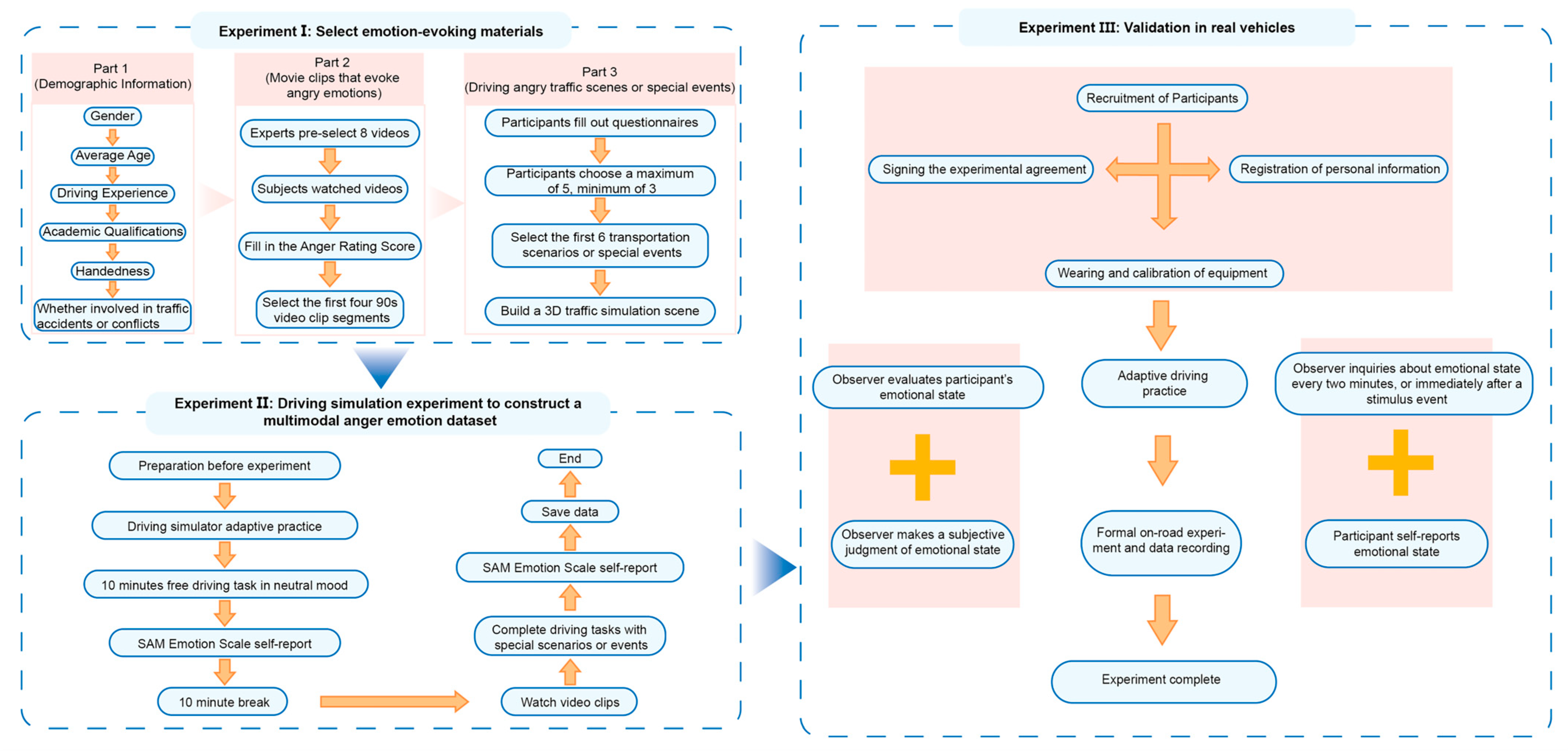


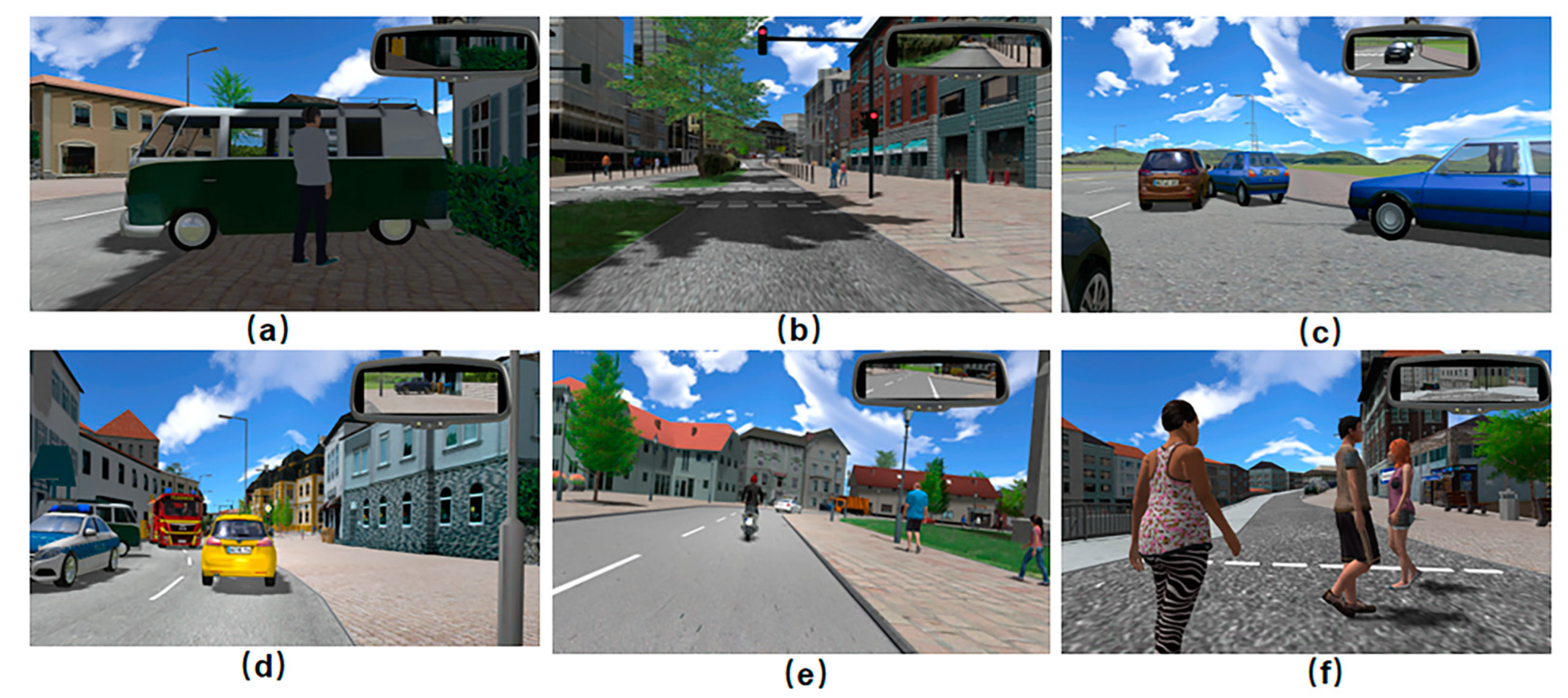
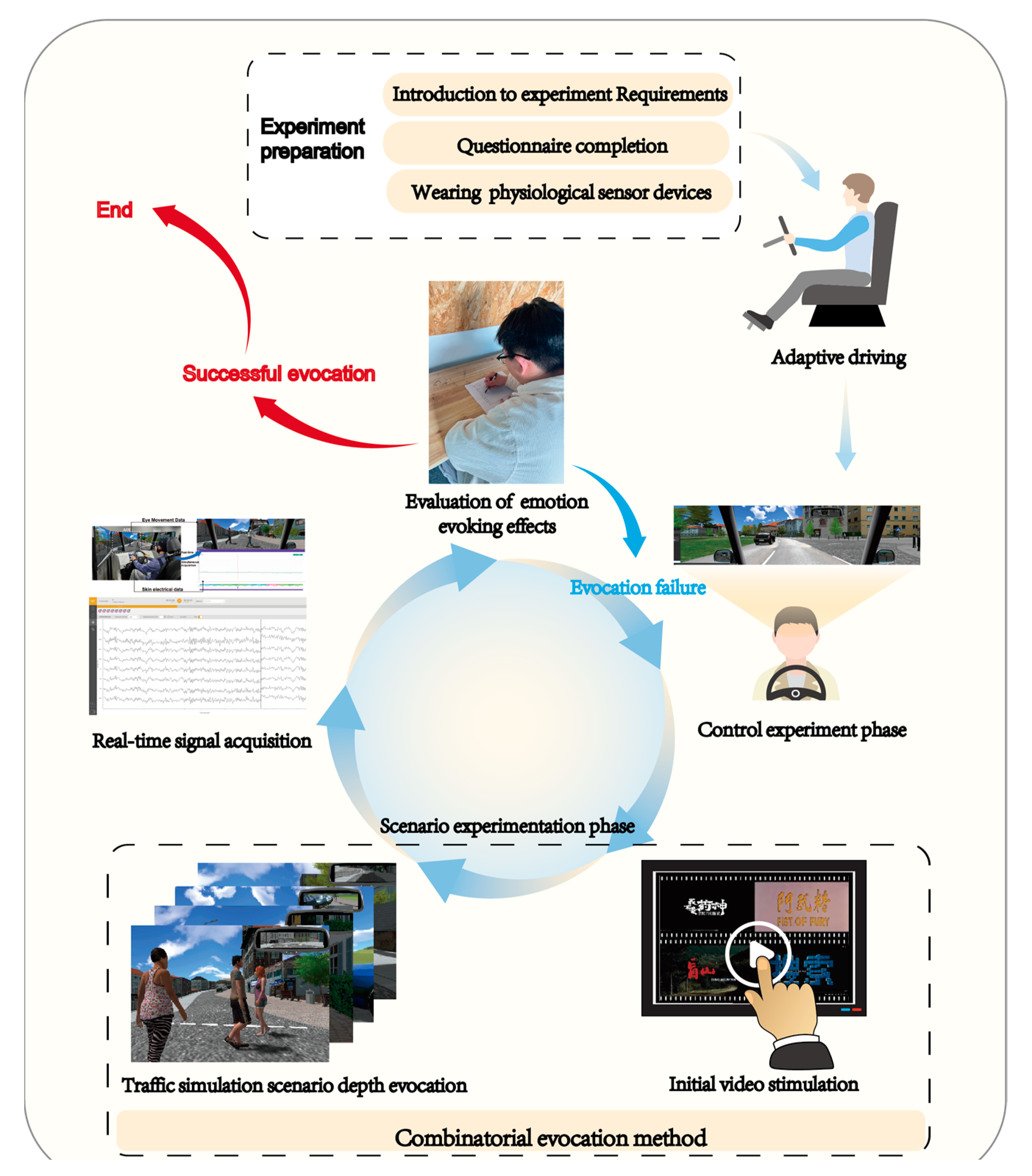
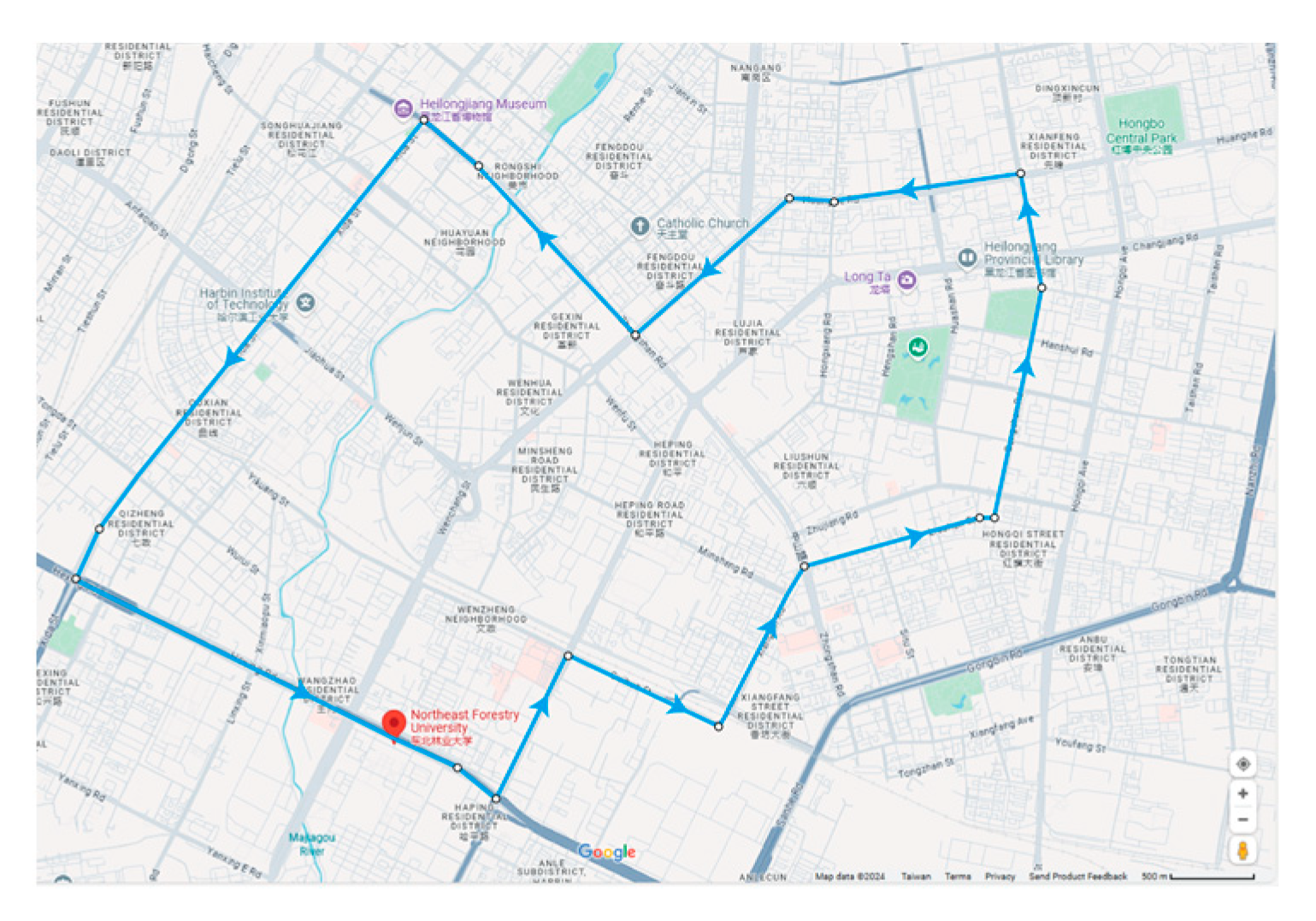
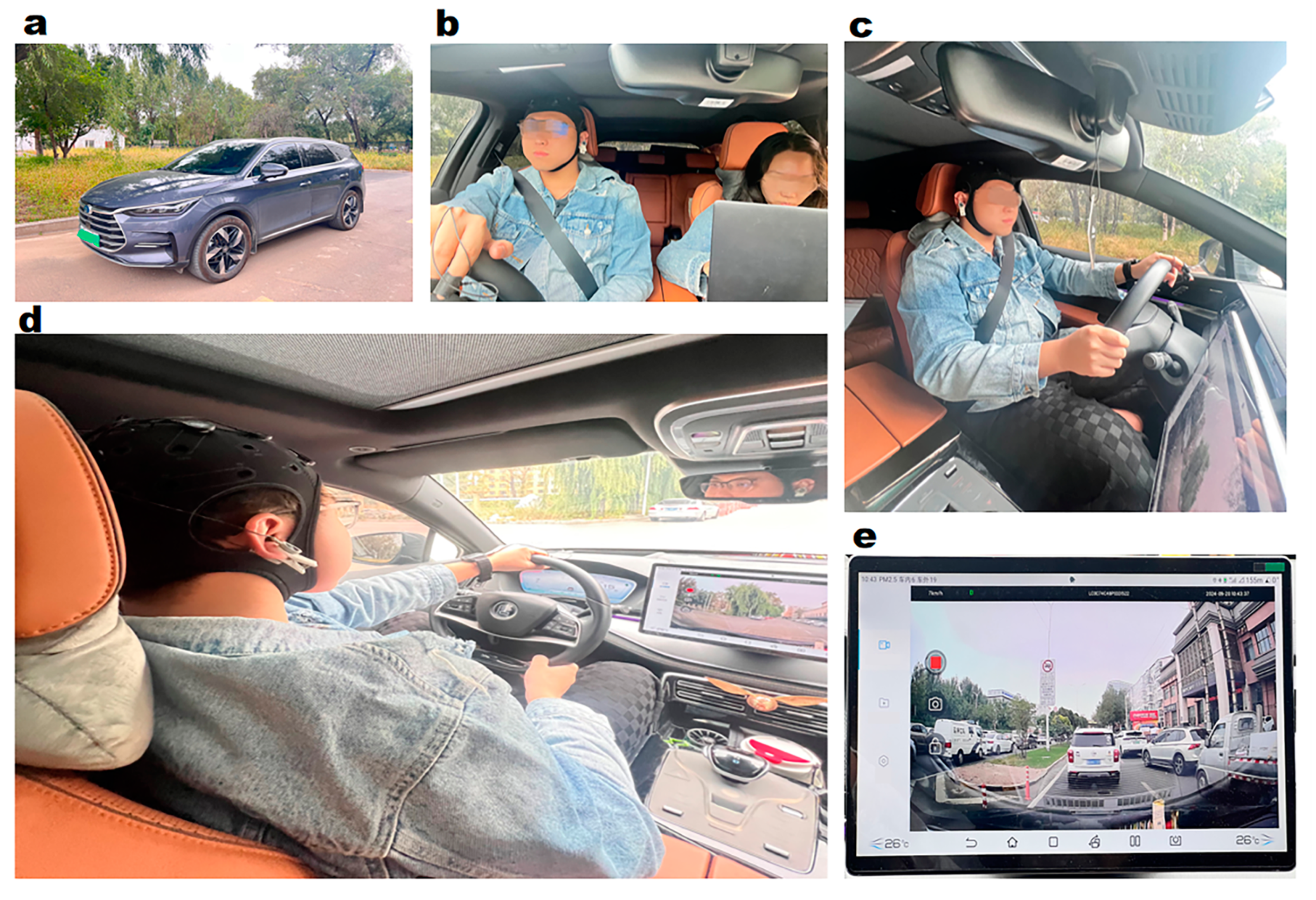

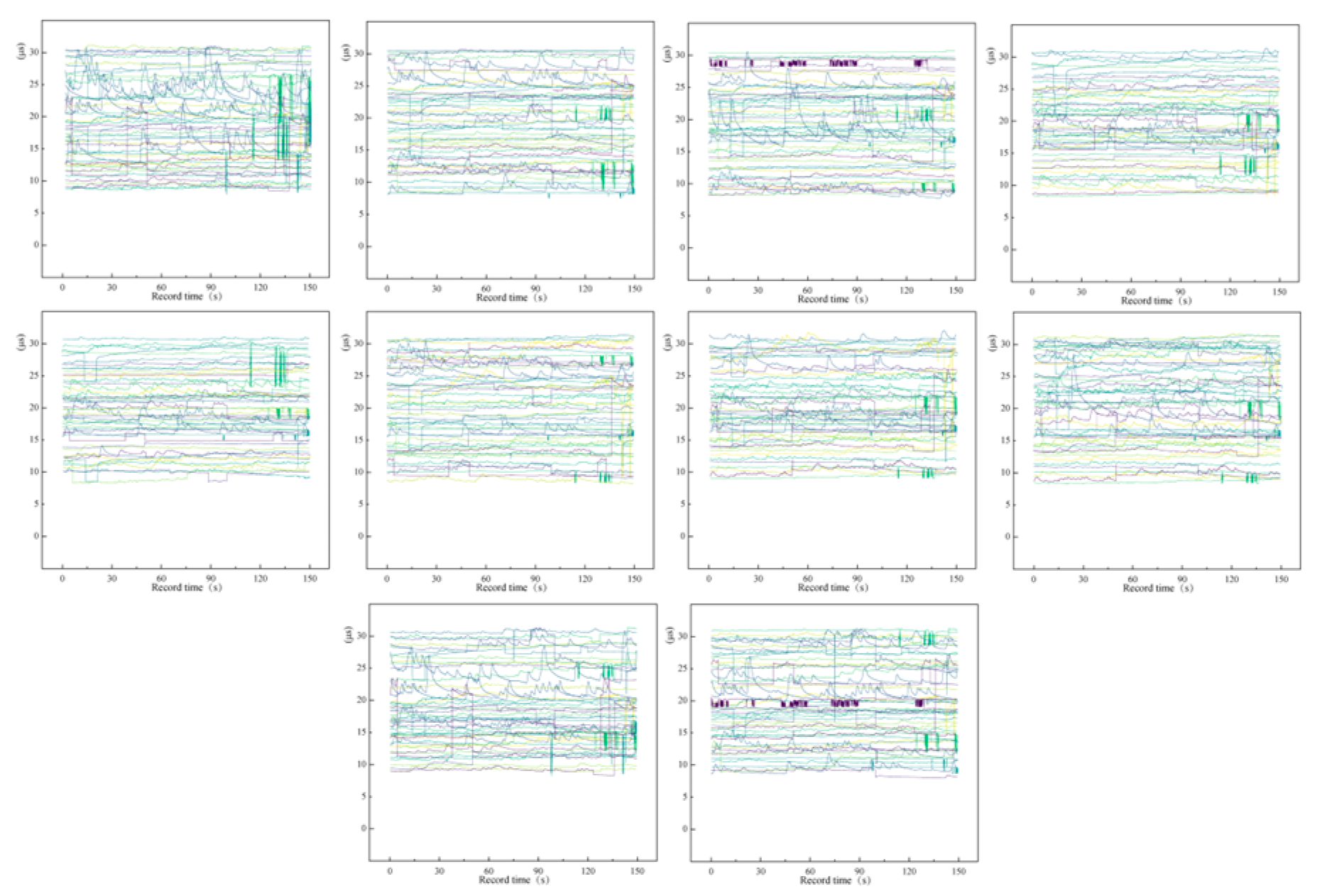

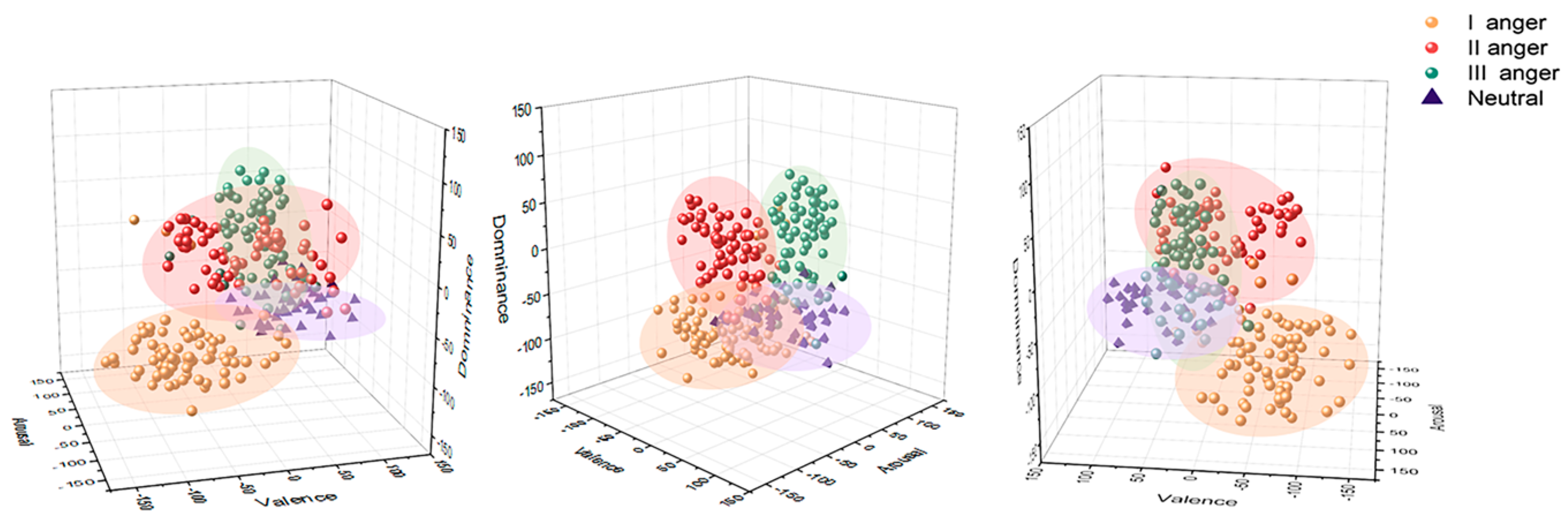

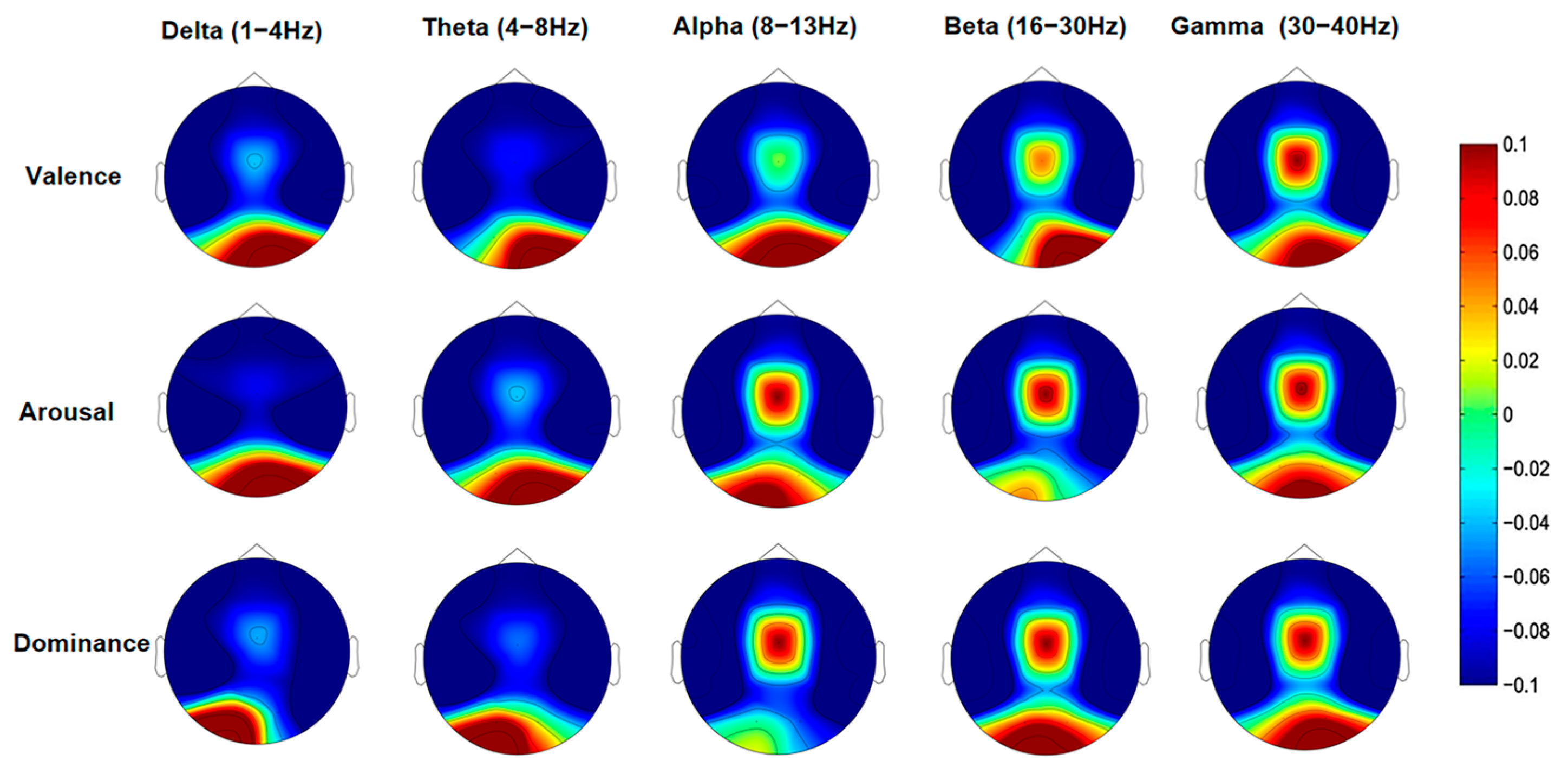
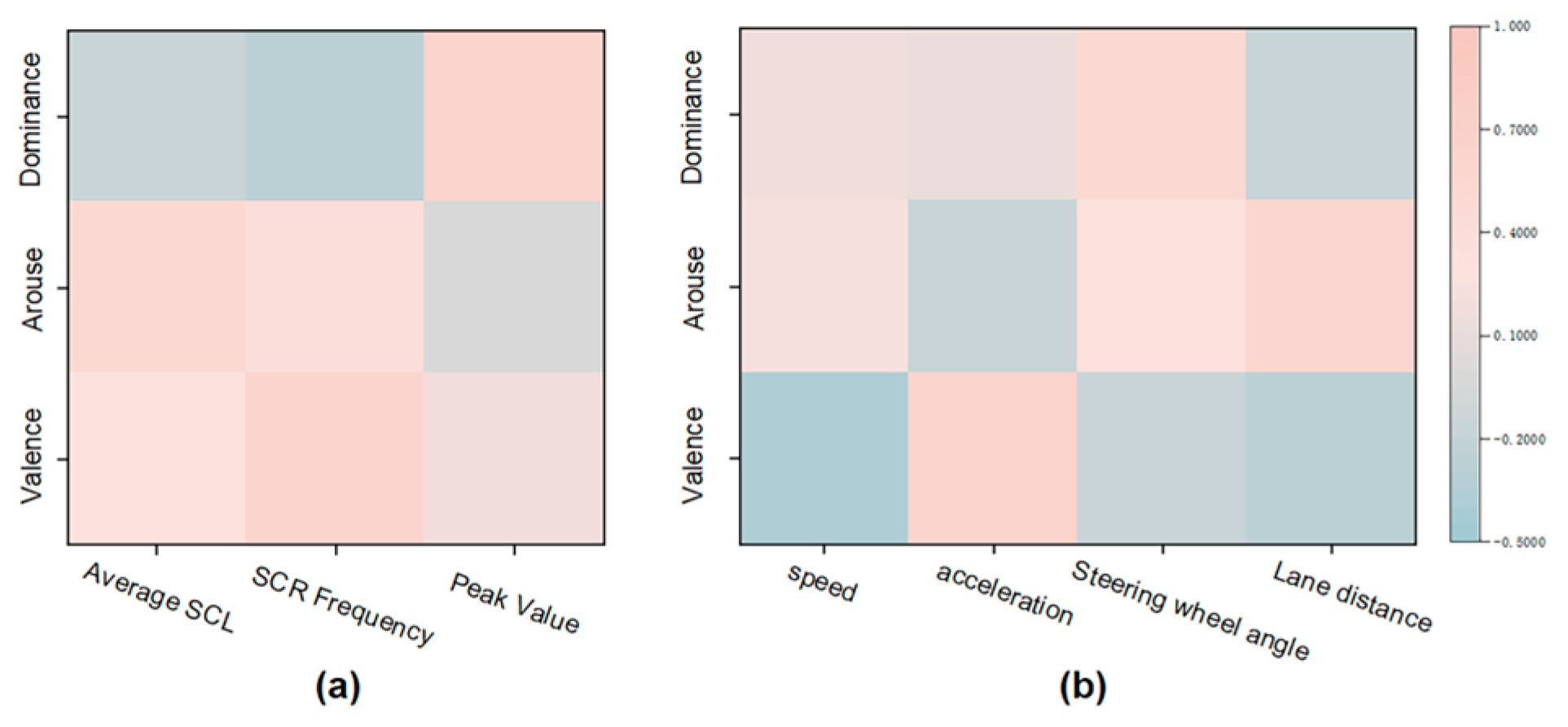
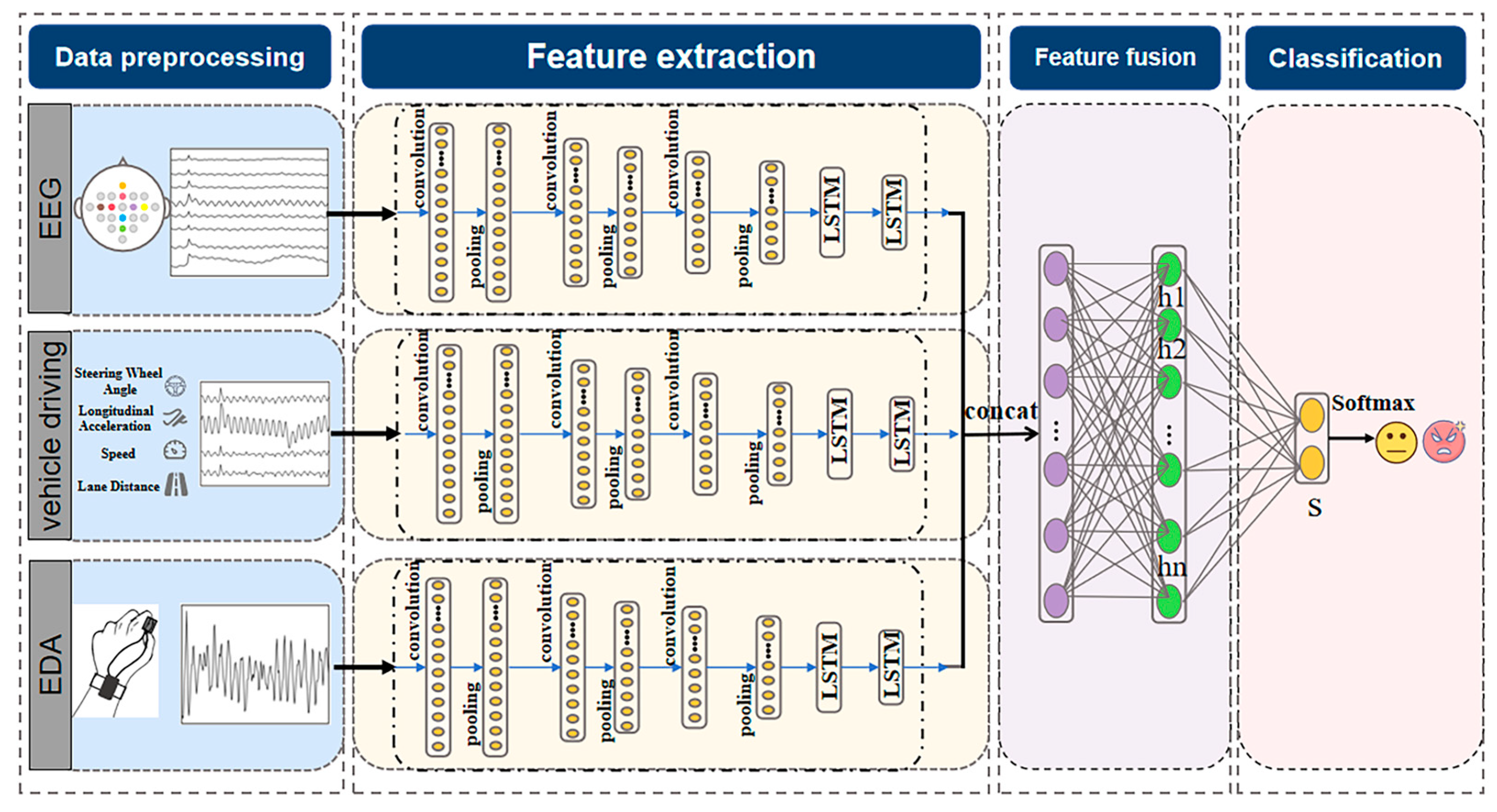
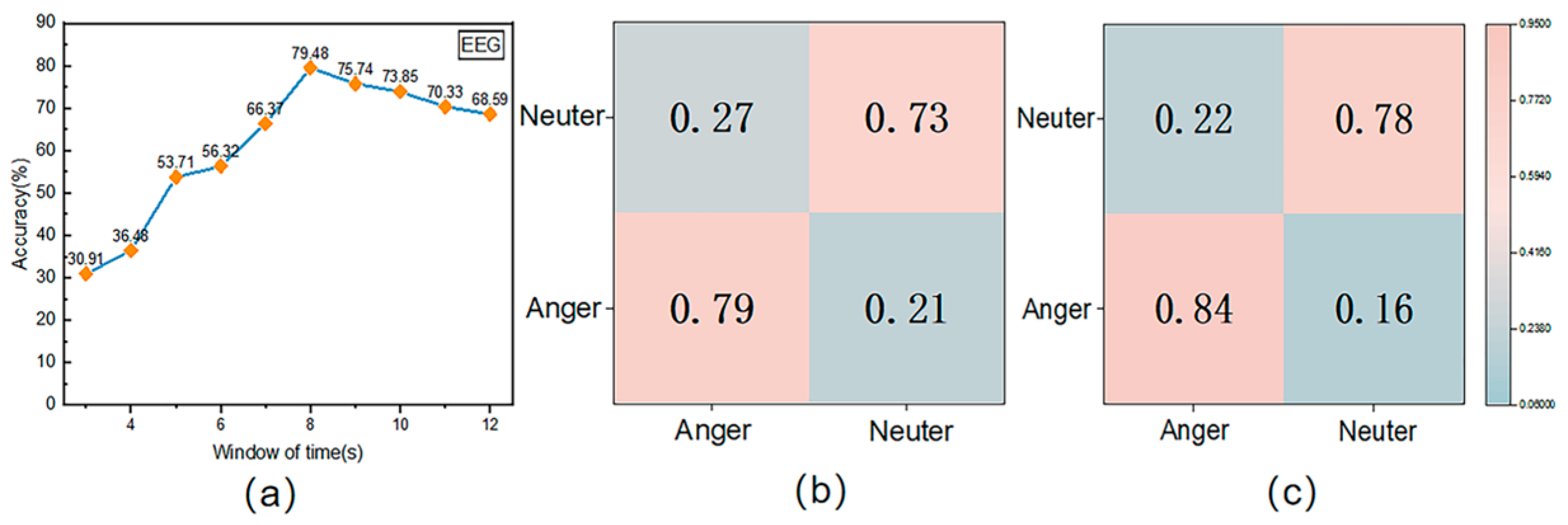
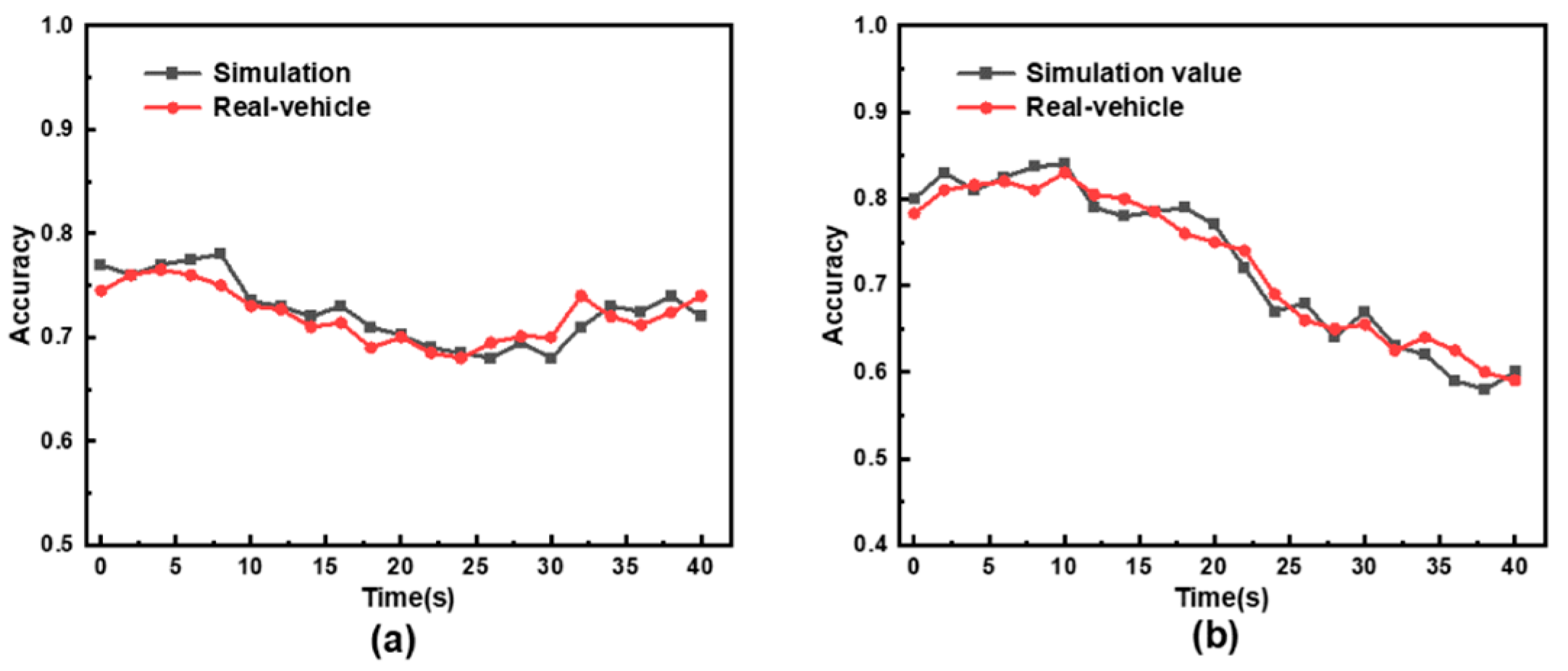
| Level | 1 | 2 | 3 | 4 | 5 | 6 | 7 | 8 | 9 |
|---|---|---|---|---|---|---|---|---|---|
| Valence | Extremely angry | Very angry | Angry | Slightly angry | Neutral | Slightly happy | Happy | Very happy | Extremely happy |
| Arousal | Extremely calm | Very calm | Moderately calm | Slightly excited | Moderately excited | Slightly excited | Excited | Very excited | Extremely excited |
| Dominance | Extremely helpless | Very helpless | Slightly controlled | Slightly suppressed | Neutral | Slightly in control | In control | Very in control | Extremely in control |
| Dataset Name | Modalities | Data Types | Amount | Application Scenarios | Emotional Appraisal Approach | Condition |
|---|---|---|---|---|---|---|
| DEAP [26] | Facial expression, EEG, Peripheral physiologic signals | Video frame, Timing data | 32, age 19–37, 16 males | Driving Emotion Recognition | Valence, Arousal, Dominance, Liking, Familiarity | Driving Simulator |
| SEED [32] | EEG | Timing data | 15, age 23, 7 males | Emotion Recognition | Positive, Neutral, Negative | Lab-controls |
| PPB-Emo [27] | EEG, Physiological signals, Vehicle driving data | Timing data | 40 | Driving Emotion Recognition | Surprised, Happy, Neutral, Angry, Fearful, Sad | Driving Simulator |
| HDD [28] | Vehicle driving data | Timing data | 104 h | Driving Behavior Analysis | Acceleration, Collision, Normal, Turn | Driving Simulator |
| FRUST [33] | Facial expression | Video frame | 43, age 20–59 30 males | Driving Frustration | Frustration, Arousal, Valence, Stress | Lab-controls |
| A2ES [29] | ECG, PPG | Timing data | 47, age 19–47 years | Emotion Recognition | Valence, Arousal, Dominance | Lab-controls |
| DPV-MFD (This work) | EEG, EDG, Vehicle driving data (Acceleration, Speed, Lane offset, Steering wheel angle) | Timing data | 56, average age 24.28 years | Driving Anger Recognition | Valence, Arousal, Dominance | Laboratory control Spontaneous emotional expression |
| Gender | Average Age | Driving Experience | Academic Qualifications | Handedness | Whether Involved in Traffic Accidents or Conflicts |
|---|---|---|---|---|---|
| 393 Male, 231 Females | 35.74 ± 9.28 | 8.29 ± 4.62 | 74 Bachelor’s degree or above | 92% Right-Handed, 8% Left-Handed | 91% Yes, 9% No |
| Problems | Frequency | Rankings | |||
| 1 | 2 | 3 | 4 | ||
| 1. The Flowers of War | 103 | 135 | 222 | 164 | 6 |
| 2. Blind Mountain | 52 | 117 | 198 | 257 | 1 |
| 3. Ding to Survive | 60 | 141 | 219 | 204 | 3 |
| 4. Schindler’s List | 64 | 133 | 241 | 186 | 5 |
| 5. Fist of Fury | 27 | 185 | 194 | 218 | 2 |
| 6. Black Coal, Thin Ice | 170 | 119 | 187 | 148 | 7 |
| 7. Caught in the Web | 45 | 173 | 209 | 197 | 4 |
| 8. To Live | 99 | 235 | 174 | 116 | 8 |
| Problems | Frequency | Rankings |
|---|---|---|
| 1. When non-motorized vehicles persistently occupy lanes designated for motorized vehicles. | 387 | 2 |
| 2. After ensuring that pedestrians are prioritized through the intersection, vehicles start and then face a prolonged red-light signal. | 406 | 1 |
| 3. When the vehicle ahead changes lanes without using a turn signal. | 274 | 7 |
| 4. When pedestrians disregard traffic signals and proceed slowly. | 365 | 3 |
| 5. While waiting at a red light, encountering an oncoming vehicle with its high beams on. | 253 | 8 |
| 6. Overloaded traffic flow causes prolonged congestion. | 318 | 5 |
| 7. Failure to pass due to randomly parked vehicles not by regulations. | 324 | 4 |
| 8. Nearby vehicles intentionally obstructing traffic. | 298 | 6 |
| 9. Obstruction of traffic by unmarked warning road works. | 171 | 9 |
| 10. Following vehicles frequently and unreasonably honking to prompt movement. | 125 | 10 |
| Emotional State | Evoking Material | Concrete Content |
|---|---|---|
| Anger | Film Clip | Blind Mountain |
| Fist of Fury | ||
| Ding to Survive | ||
| Caught in the Web | ||
| Traffic Simulation Scenario | After ensuring that pedestrians are prioritized through the intersection, vehicles start and then face a prolonged red-light signal; | |
| When non-motorized vehicles persistently occupy lanes designated for motorized vehicles; | ||
| When pedestrians disregard traffic signals and proceed slowly; | ||
| Failure to pass due to randomly parked vehicles not by regulations; | ||
| Overloaded traffic flow causes prolonged congestion; | ||
| Nearby vehicles intentionally obstruct traffic. | ||
| Neutral | Music | Natural landscape background music |
| Data Recording | Specific Projects |
|---|---|
| Participant demographic information | Gender, average age, driving experience, academic qualifications, handedness, whether involved in traffic accidents or conflicts. |
| Video material | 12 min of movie clips (4 types of movie clips, 90 s each, looped 2 times). |
| 3D Driving scene | Total 180 s with 6 traffic scenarios or special events in a randomized loop. |
| EEG data | Effective duration totaled 2297.5 min, with 2160 angry EEG data, 2435 neutral EEG data, and 8 channels for one data point. |
| EDA data | Effective duration totaled 2297.5 min, with 2160 angry EDA data and 2435 neutral EDA data, single channel, one data point per channel. |
| Vehicle driving data | Effective duration totaled 2297.5 min, speed in km/h, longitudinal acceleration, steering wheel angle and lane distance. Anger and neutral data, 2160 and 2435. |
| Emotion categories labels | 2 categories: Anger and Neutral. |
| Emotional intensity labels | SAM scale with 9 levels of validity, arousal, and dominance, 1 = not at all, 9 = completely. |
| Gender | Average Age | Driving Experience | Academic Qualifications | Handedness | Whether Involved in Traffic Accidents or Conflicts |
|---|---|---|---|---|---|
| 13 Male, 7 Females | 38.47 ± 8.28 | 11.34 ± 7.69 | 61 Bachelor’s degree or above | 95% Right-Handed, 5% Left-Handed | 93% Yes, 7% No |
| Parameter Type | Indicator Symbols | Acquisition Equipment | Sampling Frequency | Data Description |
|---|---|---|---|---|
| Electroencephalography | EEG | Eno-Bio Wireless Dry Electroencephalography System | 125 Hz | The bioelectrical activity of the cerebral cortex (μV) |
| Skin Conductivity | SC: Skin Conductance | Skin Electrical Conductivity | 64 Hz | micro-Siemens (μs) and micro-mhos (μm) |
| Speed | s | In-vehicle sensors/CAN | 8 Hz/100 Hz | 0–240 km/h |
| Longitudinal Acceleration | a | In-vehicle sensors/CAN | 8 Hz/100 Hz | [−5 m/s2,5 m/s2], −5 m/s2: indicates the maximum deceleration of the vehicle during emergency braking; +5 m/s2: indicates the maximum acceleration of the vehicle during acceleration. |
| Steering Wheel Angle | SWA | In-vehicle sensors/CAN | 8 Hz/100 Hz | [−360°,360°], negative to the left, positive to the right. |
| Lane Distance | LD | In-vehicle sensors/CAN | 8 Hz/100 Hz | Vehicle centerline distance from the left and right lane edge line, 1.8 m means in the middle of the lane, to the right, the right distance decreases, the left distance increases, to the left and vice versa. |
| Hyperparameter | Range |
|---|---|
| Batch Size | 32, 64, 128, 256 |
| Epochs | 150, 300, 450, 600 |
| Number of Feature Extraction and Fusion Modules | 2, 3, 4, 5, 6, 7, 8 |
| Dropout Rate | 0.5, 0.6, 0.7, 0.8, 0.9 |
| L2 Regularization Coefficient | 0.1, 0.01, 0.001, 1 × 10−4, 1 × 10−5 |
| Learning Rate | 0.0001, 0.001, 0.01, 0.1 |
| Number of LSTM Units | 64, 128, 256, 512 |
| Modal Information | Accuracy (%) | F1 Score (%) |
|---|---|---|
| Only EEG | 79.48% | 74.62% |
| Multimodal fusion | 83.97% | 83.76% |
| Reference | Dataset | Modalities Used | Method Used | Performance | No. Classes |
|---|---|---|---|---|---|
| [43] | 7562 samples of 186.24 min speech material | Speech, Self-reported scale | Random forest (RF), Support Vector Machine (SVM) | Accuracy: RF: 52.8%, SVM: 77.4% | Neutral, Positive, Frustrated, Anxious |
| [23] | 116 records, each record 12 features | EDA, ECG, Respiration, EMG, Finger Pressure | K-Nearest Neighbors (KNN), Marquardt Backpropagation (MBP), Resilient Backpropagation (RBP) | Accuracy: KNN: 65.33%, MBP: 73.26%, RBP: 82.6% | Fear, Anger, Boredom |
| [44] | 906 angry samples, 713 neutral samples | EEG, BVP, HR, EDA, Skin Temperature, Respiration, Self-reported scale, Driving behavior | Least squares | Accuracy: 82.2% | Anger, Neutral |
| [40] | DEAP | PPG, EDA | Transfer Learning | Accuracy: Valance: 69.8%, Arousal: 69.5% | Valance, Arousal |
| [45] | DEAP | EEG, PPG | CNN-LSTM | Accuracy: Valance: 78.72% Arousal: 79.03% | Valance, Arousal |
| Proposed model | DPV-MFD | EEG, EDA, vehicle driving data, Self-reported scale | CNN-LSTM | Accuracy: 83.97%, F1 score: 83.76% | Anger, Neutral |
Disclaimer/Publisher’s Note: The statements, opinions and data contained in all publications are solely those of the individual author(s) and contributor(s) and not of MDPI and/or the editor(s). MDPI and/or the editor(s) disclaim responsibility for any injury to people or property resulting from any ideas, methods, instructions or products referred to in the content. |
© 2024 by the authors. Licensee MDPI, Basel, Switzerland. This article is an open access article distributed under the terms and conditions of the Creative Commons Attribution (CC BY) license (https://creativecommons.org/licenses/by/4.0/).
Share and Cite
Sun, L.; Yang, H.; Li, B. Multimodal Dataset Construction and Validation for Driving-Related Anger: A Wearable Physiological Conduction and Vehicle Driving Data Approach. Electronics 2024, 13, 3904. https://doi.org/10.3390/electronics13193904
Sun L, Yang H, Li B. Multimodal Dataset Construction and Validation for Driving-Related Anger: A Wearable Physiological Conduction and Vehicle Driving Data Approach. Electronics. 2024; 13(19):3904. https://doi.org/10.3390/electronics13193904
Chicago/Turabian StyleSun, Lichen, Hongze Yang, and Bo Li. 2024. "Multimodal Dataset Construction and Validation for Driving-Related Anger: A Wearable Physiological Conduction and Vehicle Driving Data Approach" Electronics 13, no. 19: 3904. https://doi.org/10.3390/electronics13193904





